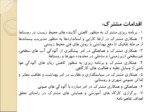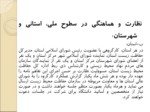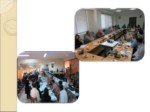بخشی از پاورپوینت
--- پاورپوینت شامل تصاویر میباشد ----
اسلاید 1 :
- تعاریف، مفاهیم و ترمینولوژی
- تاریخچه مهندسی سواحل
- رشته های مرتبط با مهندسی سواحل
- تعریف ساحل ، اجزا و قلمرو
- ساحل به عنوان یک بیوژئومورفولوژیکال سیستم
- طبقه بندی سواحل
- فرایندهای ساحلی (امواج، جزر و مد، جریانهای دریائی، باد و ...)
- بررسی فرایندهای غالب ساحلی (فرسایش، حمل و جابجائی رسوبات ورسوبگذاری)
- شناسائی لندفرمهای ساحلی و کاربری آنها
- اندازه گیری ، کمی سازی و پیش بینی تغییرات خط ساحلی
- راهبردها و راهکارهای حفاظت از سواحل
- آشنائی با تجهیزات و ماشین آلات لایروبی سواحل و بندرگاهها
اسلاید 2 :
تعریف مهندسی سواحل
علم مطالعه فرایندهای فعال در منطقه ساحلی و اثرات انها بر روی سواحل و سازه های ساحلی و برنامه ریزی برای حفاظت از انها
اسلاید 3 :
-
تاریخچه مهندسی سواحل
الف- مهندسی سواحل در دنیای باستان
The history of coastal engineering reaches back to the ancient world bordering the Mediterranean Sea, the Red Sea, and the Persian Gulf. Coastal engineering, as it relates to harbors, starts with the development of maritime traffic, perhaps before 3500 B.C. Shipping was fundamental to culture and the growth of civilization, and the expansion of navigation and communication in turn drove the practice of coastal engineering. The availability of a large slave labor force during this era meant that docks, breakwaters, and other harbor works were built by hand and often in a grand scale similar to their monumental contemporaries, pyramids, temples, and palaces. Some of the harbor works are still visible today, while others have recently been explored by archaeologists. Most of the grander ancient harbor works disappeared following the fall of the Roman Empire. Earthquakes have buried some of the works; others have been submerged by subsidence, landlocked by silting, or lost through lack of maintenance. Recently, archaeologists, using modern survey techniques, excavations, and old documents, have revealed some of the sophisticated engineering in these old harbors. Technically interesting features have shown up and are now reappearing in modern port designs. Common to most ancient ports was a well-planned and effectively located seawall or breakwater for protection and a quay or mole for loading vessels, features frequently included in modern ports (Quinn 1972).
-
اسلاید 4 :
-
Most ancient coastal efforts were directed to port structures, with the exception of a few places where life depended on coastline protection. Venice and its lagoon is one such case. Here, sea defenses (hydraulic and military) were necessary for the survival of the narrow coastal strips, and impressive shore protection works built by the Venetians are still admired. Very few written reports on the ancient design and construction of coastal structures have survived. A classic treatise by Vitruvius (27 B.C.) relating the Roman engineering experience, has survived (Pollio, Rowland, and Howe 1999). Greek and Latin literature by Herodotus, Josephs, Suetonius, Pliny, Appian, Polibus, Strabo, and others provide limited descriptions of the ancient coastal works. They show the ancients' ability to understand and handle various complex physical phenomena with limited empirical data and simple computational tools. They understood such phenomena as the Mediterranean currents and wind patterns and the wind-wave cause-effect link. The Romans are credited with first introducing wind roses (Franco 1996).
-
اسلاید 5 :
-
ب- مهندسی سواحل قبل از دوره رومیان
Most ancient coastal efforts were directed to port structures, with the exception of a few places where life depended on coastline protection. Venice and its lagoon is one such case. Here, sea defenses (hydraulic and military) were necessary for the survival of the narrow coastal strips, and impressive shore protection works built by the Venetians are still admired. Very few written reports on the ancient design and construction of coastal structures have survived. A classic treatise by Vitruvius (27 B.C.) relating the Roman engineering experience, has survived (Pollio, Rowland, and Howe 1999). Greek and Latin literature by Herodotus, Josephs, Suetonius, Pliny, Appian, Polibus, Strabo, and others provide limited descriptions of the ancient coastal works. They show the ancients' ability to understand and handle various complex physical phenomena with limited empirical data and simple computational tools. They understood such phenomena as the Mediterranean currents and wind patterns and the wind-wave cause-effect link. The Romans are credited with first introducing wind roses (Franco 1996).
-
اسلاید 6 :
-
The earliest were rock cut, in that natural features like offshore reefs were adapted to give shelter to craft riding at anchor.
- In the second group, vertical walls were built on convenient shallows to serve as breakwaters and moles. Harbors of this type were in protected bays, and often the walls connected with the defenses of a walled town (for example, ancient Tyre on the Lebanese coast). Often these basins were closeable to traffic using chains to prevent the entry of enemy ships (Franco 1996).
- The third group were harbors that were imposed on even unpromising coasts by use of Roman
innovations such as the arch and improved hydraulic cement. Projects like this required the engineering, construction, and financing resources of a major empire.
-
اسلاید 7 :
-
All ancient ports had one thing in common: they had to be kept clear of silt at a time when mechanical dredging was unknown. This was accomplished by various means. One was by designing the outer parts of the harbor so that they deflected silt-bearing currents. The second was by allowing a controlled current to flow through the port or by flushing it out when necessary by means of channels. For example, at Sidon, a series of tanks (like swimming pools) were cut into the harbor side of a natural rock reef. The tanks filled with clear water that was held in place with sluice gates. When the gates were opened, currents of clear water would flush the inner harbor. Documentary and archaeological evidence show that both Tyre and Sidon were flourishing and powerful ports from the Bronze Age through the Roman era and must therefore have been kept clear of silt for over a thousand years (Frost 1963). Another method of preventing silt consisted of diverting rivers through canals so that during part or much of the year, the flow would enter the sea at location well away from the harbor.
-
اسلاید 8 :
-
The origins of breakwaters are unknown. The ancient Egyptians built boat basins with breakwaters on the Nile River at Zoser's (Djoser) step pyramid (ca. 2500 B.C.) (Inman 2001). The Minoans constructed a breakwater at Nirou Khani on Crete long before the explosion of Santorini (Thera) in ca. 1500 B.C. The breakwater was small and constructed of material taken from nearby dune rock quarries (Inman 1974, Figure 4). In the Mediterranean, size and sophistication of breakwaters increased over time as the Egyptian, Phoenician, Greco-Macedonian, and Roman civilizations developed and evolved. Breakwaters were built in China but generally at a later date than in the Mediterranean. Probably the most sophisticated man-made harbor of this era was the first harbor of Alexandria, Egypt, built
west of Pharos Island about 1800 B.C. by the Minoans. The main basin, built to accommodate 400 ships about 35 m in length, was 2,300 m long, 300 m wide and 6-10 m deep. Large stone blocks were used in the many breakwaters and docks in the harbor. Alexander the Great and his Greek successors rebuilt the harbor (300-100 B.C.) in monumental scale. The Island of Pharos was joined to the mainland by a 1.5 km breakwater with two openings dividing two basins with an area of 368 hectares (910 acres) and 15 km of quay front. Alexandria is probably best known for the 130m-high lighthouse tower used to guide ships on a featureless coast to the port from 50 km at sea. The multi-storied building was built with solid blocks of stone cemented together with melted lead and lined with white stone slabs. Considered one of the Wonders of the
Ancient World, it eventually collapsed due to earthquakes between 1326 and 1349 (Franco 1996, Empereur 1997).
-
اسلاید 9 :
-
Another feature of the Greek harbors was the use of colossal statues to mark the entrances. Colossal statues of King Ptolemy, which stood at the base of the lighthouse, have been found with the lighthouse debris. Historians report the most famous harbor statue was the 30 m high Colossus of Rhodes, which stood on the breakwater heads. Three ancient windmill towers are still surviving upon the Rhodes breakwater (Franco 1996). Frost (1963) notes that the Greeks had used hydraulic cement long before the Romans.
ج- مهندسی سواحل در رم باستان
The Romans introduced many revolutionary innovations in harbor design. They learned to build walls underwater and constructed solid breakwaters to protect exposed harbors. They used metal joints and clamps to fasten neighboring blocks together and are often credited with discovering hydraulic cement made with pozzolanic ash obtained from the volcanic region near Naples, which hardens underwater. Frost (1963) notes that the Greeks had used hydraulic cement long before the Romans. The Romans replaced many of the Greek rubble mound breakwaters with vertical and composite concrete walls
-
اسلاید 10 :
The Romans introduced many revolutionary innovations in harbor design. They learned to build walls underwater and constructed solid breakwaters to protect exposed harbors. They used metal joints and clamps to fasten neighboring blocks together and are often credited with discovering hydraulic cement made with pozzolanic ash obtained from the volcanic region near Naples, which hardens underwater. Frost (1963) notes that the Greeks had used hydraulic cement long before the Romans. The Romans replaced many of the Greek rubble mound breakwaters with vertical and composite concrete walls . These monolithic coastal structures could be built rapidly and required little maintenance. In In most cases, rubble or large stone slabs were placed in front of the walls to protect
against toe scour. The Romans developed cranes and pile drivers and used them extensively in their construction. This technology also led them to develop dredges. Another advanced technique used for deep-water applications was the watertight floating cellular caisson, precursor of the modern day monolithic breakwater. some cases wave reflection may have been used to prevent silting. They also used low, water-surface breakwaters to trip the waves before they reached the main breakwater. The peculiar feature of the vertical wall breakwater at Thapsus (Rass Dimas, Tunisia) was the presence of vents through the wall to reduce wave impact forces. This idea is used today in the construction of perforated caisson breakwaters (Franco 1996). Using some of these techniques, the Romans built sophisticated breakwaters at Aquileia, Italy (ca. 180 B.C.),
and at Caesarea, Israel (ca. 20 B.C.).














